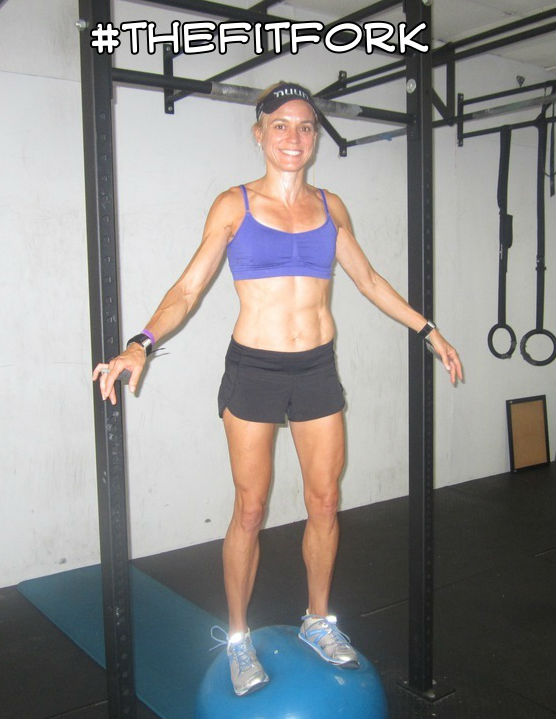Sitting alone in the corner
Super-sized yet oh-so taut,
Let me re-introduce myself,
Mr. Ball, show me what you’ve got.
To some, you’re just a child’s plaything,
But, oh, I know, you’re so much more.
We’ll rendezvous, just me and you,
Let’s rock and roll from quads to core.
Hello crunches, planks and deep side bends,
You’ve got magic moves, not for the weak.
For sure, I’ll be sore but craving more,
So let’s hook up “same time next week.”
I know, it’s weird, but I’m in a meaningful relationship with my exercise ball. Obviously normal people don’t feel the need to wax poetic about a giant rubber sphere. So, how much do I love my exercise ball? Let me count the ways:
- With an exercise ball, I can perform a seemingly never-ending array of fitness moves that target every part of the body (I’ve included four great entry-level ones to start with below).
- Many standard gym moves, like bicep curls or skull crushers, can be made more challenging by sitting, bridging or, in some other way, balancing on a ball.
- As far as fitness equipment goes, an exercise ball fits perfectly into anyone’s budget. There are plenty of options in the $20 buck range.
- It hardly takes up any space. When not in use, I hide my exercise ball in the bathtub and close the curtain!
- It’s easy to take on a trip, just deflate and toss in the suitcase. Most hotels have an air pump and will send up a bell hop to inflate or deflate, as needed.
- When each of my boys was a baby, gently bouncing on an exercise ball while holding him would help with fussiness.
Semi-Scientific Words on Proprioceptors and the Exercise Ball
The job of proprioceptors is to connect our brains with our bodies; in other words, to help us have a ‘sense of self.’ In constant communication with the brain and spinal cord, these neuromuscular receptors are linked to how the body moves through time and space. Proprioceptors run interference on everything imaginable, from the position of a joint to the tension of a muscle. Procioceptors in tip top shape are essential for good balance and, according to an interesting article in Runner’s World, we’ll lose up to 75 percent of our balancing ability between the ages of 25 to 75. You can join me in trying to fend off Father Time and challenge your proprioceptors to stay young by performing tasks on an exercise ball. The body’s increased need for stability and balance on an exercise ball stimulates the workload of proprioceptors, which in turn can make you a more agile, aware and injury-free athlete.
Try These Exercise Ball Moves at Home
Triceps Dip
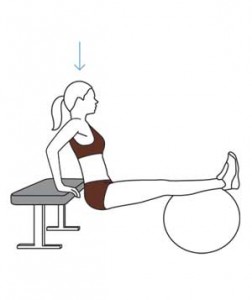 Sit on a workout bench or sturdy chair and place hands on edge with fingers forward. Rest your calves and ankles on top of exercise ball. Next, straighten arms while lifting hips upward. Bend arms to lower torso and then straighten arms to return to starting position. Three sets of 10 reps each.
Sit on a workout bench or sturdy chair and place hands on edge with fingers forward. Rest your calves and ankles on top of exercise ball. Next, straighten arms while lifting hips upward. Bend arms to lower torso and then straighten arms to return to starting position. Three sets of 10 reps each.
Low-Ab Crunch
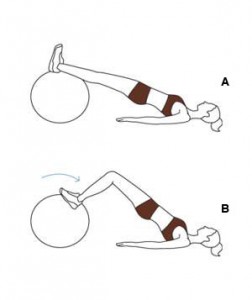 Lie on your back with arms at side and calves resting on the ball. Without arching back, raise hips upward while keeping abdominal muscles engaged for support (see A). With hips still raised, bend your knees and roll the ball toward body with feet until they’re flat on top of the ball. Slowly return to the starting position. Three sets of 10 reps each.
Lie on your back with arms at side and calves resting on the ball. Without arching back, raise hips upward while keeping abdominal muscles engaged for support (see A). With hips still raised, bend your knees and roll the ball toward body with feet until they’re flat on top of the ball. Slowly return to the starting position. Three sets of 10 reps each.
Plank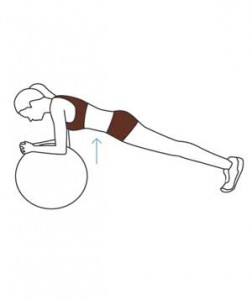
Keeping toes on the ground, lean on the top of ball with forearms while keeping remainder of body in a tight plane. Engage abs and align neck with spine for proper form. Three sets of 30 – 90 second position holds.
Crunch
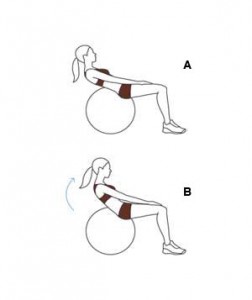 Rest middle back on top of ball while keeping arms straight and palms placed on upper thighs (see A). Next, slowly curl upper body forward, one vertebra at a time, while keeping hands on top of thighs. After each crunch, lower back slowly to the starting position. Three sets of 10 reps each.
Rest middle back on top of ball while keeping arms straight and palms placed on upper thighs (see A). Next, slowly curl upper body forward, one vertebra at a time, while keeping hands on top of thighs. After each crunch, lower back slowly to the starting position. Three sets of 10 reps each.

